PR
X
Keyword Search
▼キーワード検索
Comments
私はイスラム教徒です@ Re:アイルランド・ロンドンへの旅(その131): ロンドン散策記・アルバート記念碑(Albert Memorial)-2(11/06)
神神は言った: コーランで 『 (21) 人々…
私はイスラム教徒です@ Re:アイルランド・ロンドンへの旅(その122): ロンドン散策記・Victoria and Albert Museum・ヴィクトリア&アルバート博物館-5(10/28)
神神は言った: コーランで 『 (21) 人…
【時間が出来れば、…
 New!
Gママさん
New!
Gママさん
続日本100名城東北の… New! オジン0523さん
岡山県岡山県立森林… New!
隠居人はせじぃさん
New!
隠居人はせじぃさん
ムベの実を開くコツ… noahnoahnoahさん
noahnoahnoahさん
エコハウスにようこそ ecologicianさん
 New!
Gママさん
New!
Gママさん続日本100名城東北の… New! オジン0523さん
岡山県岡山県立森林…
 New!
隠居人はせじぃさん
New!
隠居人はせじぃさんムベの実を開くコツ…
 noahnoahnoahさん
noahnoahnoahさんエコハウスにようこそ ecologicianさん
Calendar
カテゴリ: 海外旅行
「Irish National Stud & Gardens・アイリッシュ・ナショナル・スタッド & ガーデンズ」を
後にして、 次の目的地の「Athron Castle・アスローン城」に向かう 。
再びM7を利用して西に進み、Junction 14 Mayfieldにて R445 と R420 を利用して Tullamore
まで進む。
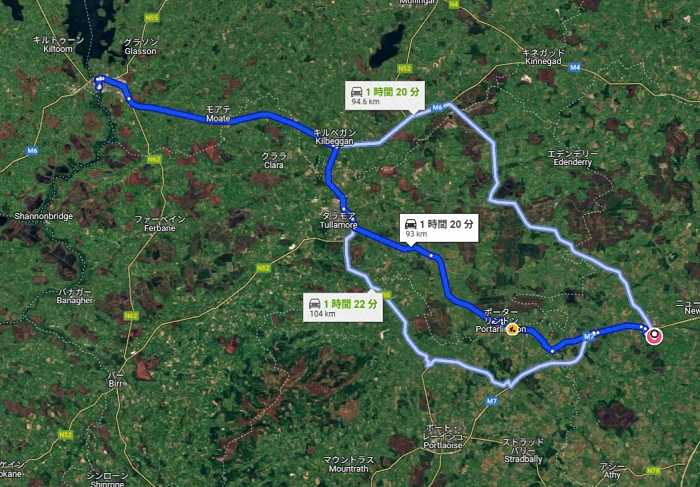
その後 N52 に移りM6,N6を進み、激しく天候の変わる中、OMACH・オマーにて高速を降りる。
途中、 タブレットのナビの現在地指示アイコンが動かなくなっているのを発見 。
そして数分後に突然動き出すことを何回か繰り返したのであった 。
おそらく、 GPS信号が弱い場所があり、現在地指示アイコンが動かなくなっていた のであろう。
アイルランドは日本のようにどこでも通信エリアが整備されている訳ではなく、田舎のほうでは
電波が弱く?無く?なってしまう場合があるようであった。
その後は、旅友Hさんがインストールしていた、Apple純正アプリ「マップ」の応答性が比較的
良いことが判明したので、我がiphonesにも急遽インストールして、これを使ったのであった。
GPS信号の強弱の関係で完璧ではなかったが、このナビだと、ラウンドアバウトでは日本語音声で
「ロータリー、2つ目の出口です」などと案内してくれ、とても分かりやすく、感動ものなので
あった。

そして Athlone・アスローンの街の中を走り「Athlone Castle・アスローン城」の到着。
中央にシャノン川が流れ、その側に13世紀に建てられた城がどっしりと構えていた。
アスローンはアイルランド島のほぼ中央に位置するため、長い間戦略上の重要地点 として
栄えて来た町。周辺には初期キリスト教修道院跡のクロンマクノイズがあった。
「Athlone Castle・アスローン城」の航空写真 をネットから。
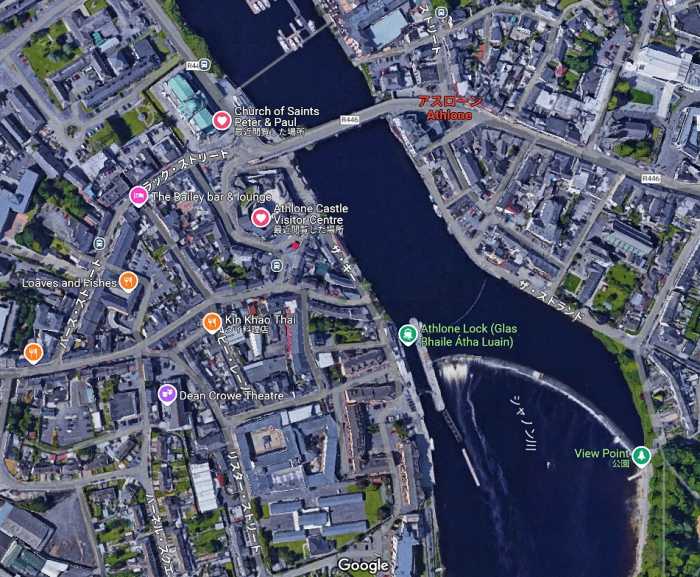
ATHLONE CASTLE 」。

ズームして。
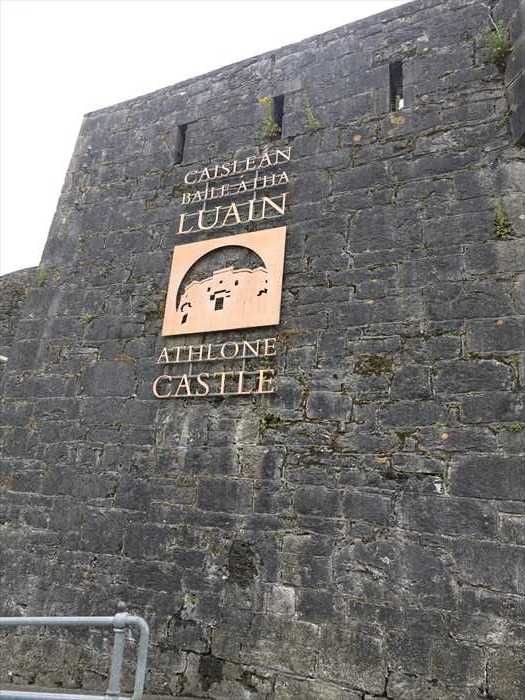
「 ATHLONE CASTLE・ アスローン城」は、12世紀から今日までの豊かな歴史を体験できる
魅力的な観光施設。戦略的要衝として繰り返し包囲戦に晒されたドラマを、最新の展示体験
として“体感”できるのが大きな魅力なのであった。
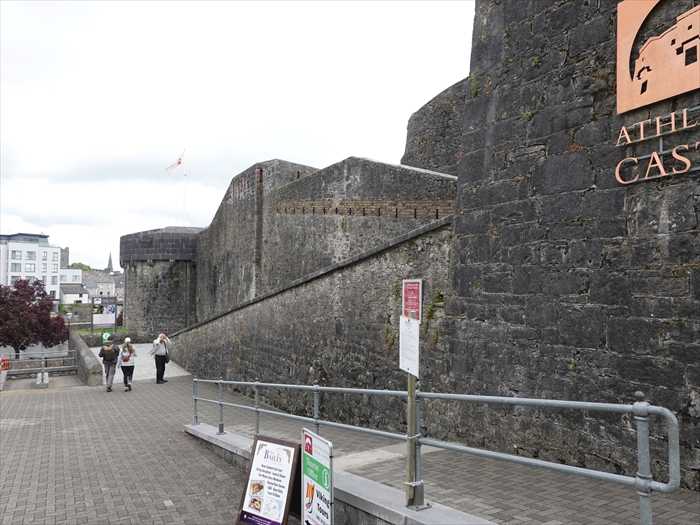
スロープを上って行く旅友。
石の壁には 銃眼用の狭間(防御用の穴や窓) が設けられていた。
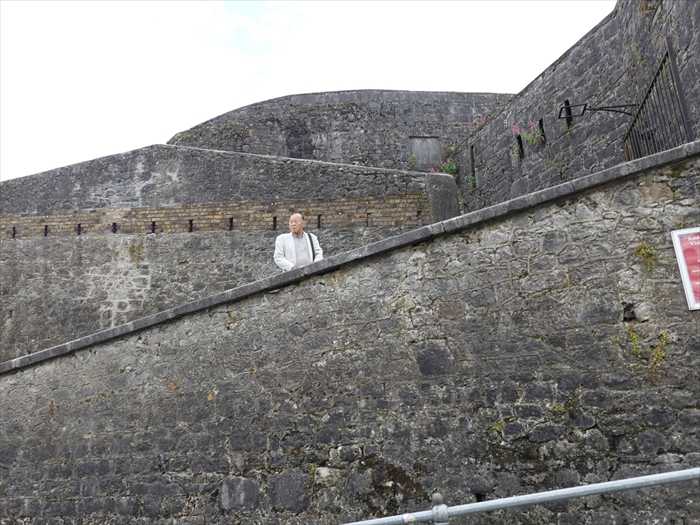
入城料はSeniorで8€/人 。
「i」マーク:
一般的に、観光案内所を示すマークとして広く認知されている。
このマークのある場所では、JNTOが提供する情報やサービスを受けることができるのであった。
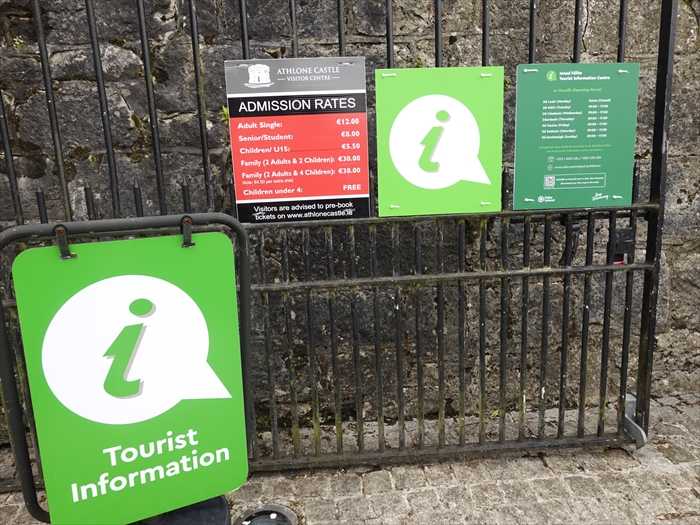
後にして、 次の目的地の「Athron Castle・アスローン城」に向かう 。
再びM7を利用して西に進み、Junction 14 Mayfieldにて R445 と R420 を利用して Tullamore
まで進む。

その後 N52 に移りM6,N6を進み、激しく天候の変わる中、OMACH・オマーにて高速を降りる。
途中、 タブレットのナビの現在地指示アイコンが動かなくなっているのを発見 。
そして数分後に突然動き出すことを何回か繰り返したのであった 。
おそらく、 GPS信号が弱い場所があり、現在地指示アイコンが動かなくなっていた のであろう。
アイルランドは日本のようにどこでも通信エリアが整備されている訳ではなく、田舎のほうでは
電波が弱く?無く?なってしまう場合があるようであった。
その後は、旅友Hさんがインストールしていた、Apple純正アプリ「マップ」の応答性が比較的
良いことが判明したので、我がiphonesにも急遽インストールして、これを使ったのであった。
GPS信号の強弱の関係で完璧ではなかったが、このナビだと、ラウンドアバウトでは日本語音声で
「ロータリー、2つ目の出口です」などと案内してくれ、とても分かりやすく、感動ものなので
あった。

そして Athlone・アスローンの街の中を走り「Athlone Castle・アスローン城」の到着。
中央にシャノン川が流れ、その側に13世紀に建てられた城がどっしりと構えていた。
アスローンはアイルランド島のほぼ中央に位置するため、長い間戦略上の重要地点 として
栄えて来た町。周辺には初期キリスト教修道院跡のクロンマクノイズがあった。
「Athlone Castle・アスローン城」の航空写真 をネットから。

ATHLONE CASTLE 」。

ズームして。

「 ATHLONE CASTLE・ アスローン城」は、12世紀から今日までの豊かな歴史を体験できる
魅力的な観光施設。戦略的要衝として繰り返し包囲戦に晒されたドラマを、最新の展示体験
として“体感”できるのが大きな魅力なのであった。

スロープを上って行く旅友。
石の壁には 銃眼用の狭間(防御用の穴や窓) が設けられていた。

入城料はSeniorで8€/人 。
「i」マーク:
一般的に、観光案内所を示すマークとして広く認知されている。
このマークのある場所では、JNTOが提供する情報やサービスを受けることができるのであった。

This Natiohal Monument is in the care of the Commissioners of Public Works for the
State under the provisions of the National Monuments Acts.
The Pubtic are requested to aid the Commissioners in preserving it.
Injury or defacement is severely punishabLe by Law.
【この国定記念物は、「国定記念物法」の規定に基づき、国家のために公共事業委員会の
管理下にあります。
一般の皆様には、この記念物の保護にご協力いただくようお願いいたします。
損傷や落書きなどの行為は、法律により厳しく罰せられます。】と。
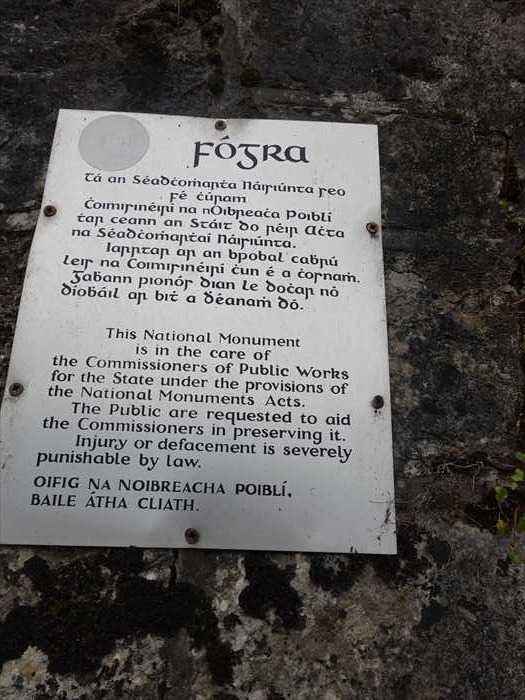
「 ATHLONE CASTLE・アスローン城 」城内への 入口門 。

「 ATHLONE CASTLE・アスローン城 」は、アダムソン城とも呼ばれ、アイルランドの
ウェストミース州アスローンにある 12世紀に建てられた城 。
アスローンの記録に残る最古の「城」は、1129年にコノートの王タイアデルバッハ・ウア・
コンホベアによって建てられた木造建築物で、おそらく現在の城の場所に建てられたと
考えられている。現在も残る石造りの城は1210年に遡り、ジョン王のために、アイルランドの
法務長官であったノーリッジのジョン・ド・グレイ司教によって建てられた。
この城は、アスローンの川の渡河地点を守り、ノルマン人のコノートへの進軍を容易にする
ための橋頭堡となることを目的として建設された。
アスローン城ビジターセンター 。
アスローンの城の中に入ると写真の要塞塔があった。
要塞塔の中にはアスローン・キャスル・ビジターセンター があり、大規模な改修を経て
2012年にリニューアルオープンしたと。要塞塔の前に設置された2つの迫撃砲は、
ウィリアマイト戦争にまでさかのぼると考えられている。
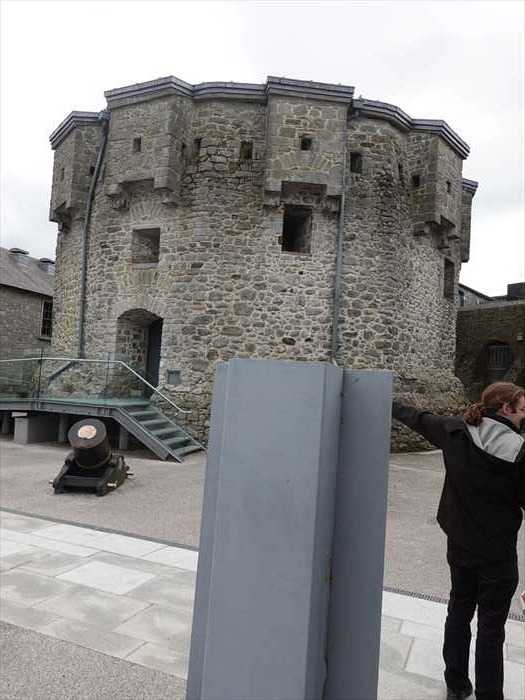
城内には大砲の如き夜間照明装置が設置されていた。
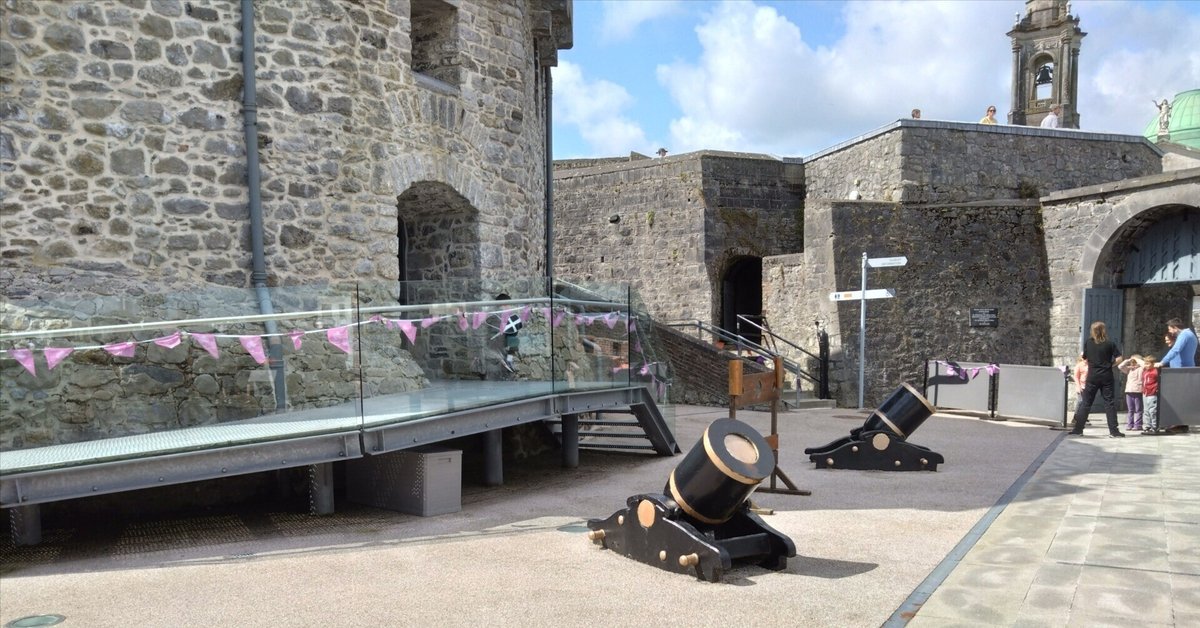
アスローン城は博物館と体験型展示施設として大きく整備された と。
🔹 展示内容:
・アスローンの歴史・文化
・包囲戦の360度映像体験
・中世の暮らし、兵器、服装などのインタラクティブ展示
・サージェント・カスチュームなど英雄人物の紹介
・アイルランドの伝統音楽や詩人、ジョン・マコーマック(テノール歌手)の
・展示(2014年追加)
チケット売り場にあった 騎士像 。
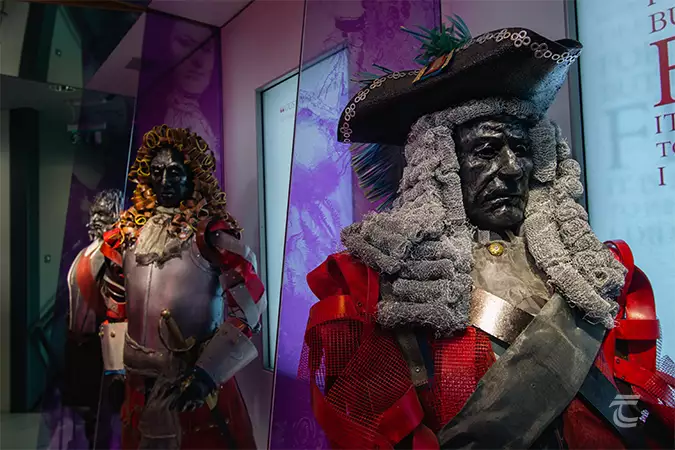
城内の写真撮影はNO FLASHっであれば可と。
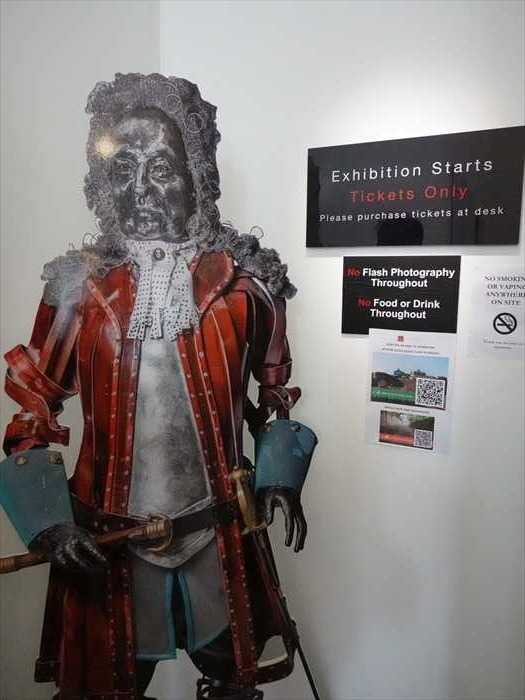
「 EARLY SETTLEMENT AT ATHLONE
Athlone is located on the intersectlon of along gravel ridge with the Shannon to provide
a convenient river crossing. Its name is anglicisation of the lrish Ath Luain,meaning
either the ford of Luan or the ford of the haunch. The recovery from the riverbed of
almost a score of Neolithic stone axeheads and more than fifty Bronze Age weapons
and ornarnents indicates the ford's importance in prehistoric times. Survivmg graveslabs
suggest that Athlone was an Early Christian settlernent site, but much inferior in
importance to Clonmacnoise, which that time was also the principal crossing point on
the mid-Shannon.
ln the twelfth century the balance swung in favour of Athlone with the rise to power of
the first bridges and castle, and used the crossing to make frequent belligerent incursions
into Meath. They also supported the church-reform movement by founding 3 Cluniac
priory on the west bank of the river.
【アスローンにおける初期の定住
アスローンは、砂利の多い長い尾根とシャノン川が交差する地点に位置し、川を渡るのに便利な
場所にあります。その地名「Athlone」は、アイルランド語の「Ath Luain(ア・ルアン)」の
英語化で、「ルアンの渡し場」または「腰(尻)の渡し場」という意味です
川底から発見された約20点の新石器時代の石斧や、50点を超える青銅器時代の武器・装飾品の
存在は、この渡し場が先史時代においても非常に重要だったことを示しています。
現存する墓石からは、アスローンが初期キリスト教時代に定住地であったことがうかがえますが、
当時の重要性は、同じくシャノン中流の主要な渡河地点であり宗教的中心でもあった
クロンマクノイズ(Clonmacnoise)には及びませんでした。
12世紀になると、アスローンの地位は大きく上昇します。最初の橋と城の建設によりこの場所の
戦略的価値が高まり、アスローンはしばしばミース地方(Meath)への軍事的侵攻の拠点として
使われるようになります。また、シャノン川西岸には、教会改革運動の一環としてクリュニ
(Cluniac)修道会による修道院が建設されました。】
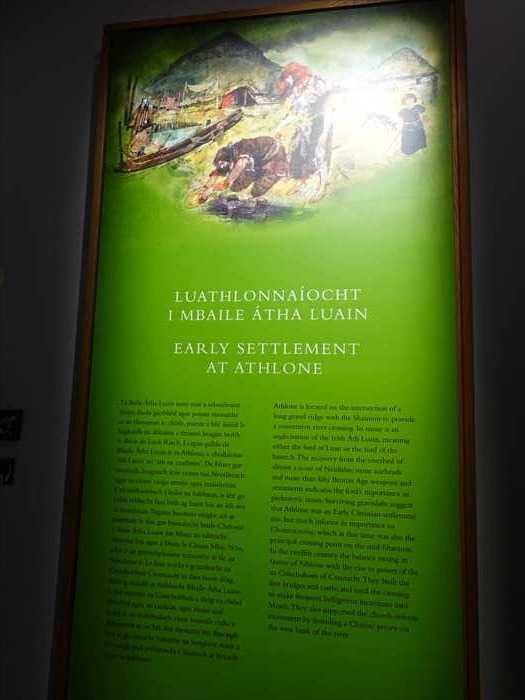
「❝894。A VICTORY WAS GAINED OVER THE CONNACHTMEN AT
ATHL〇NE
BY THE MEN OF WEST MEATH
AND A SLAUGHTER
OF HEADS LEFT BEHIND WITH THEM❞
ANNALS
OF FOUR MASTERS」
【アイルランドの歴史書『 フォア・マスターズ年代記(Annals of the Four Masters) 』の一節】
894年。アスローンにおいて、ウェスト・ミースの人々がコノート人に勝利し、彼らに多くの
首を残していった(=大虐殺を行った)。
フォア・マスターズ年代記】
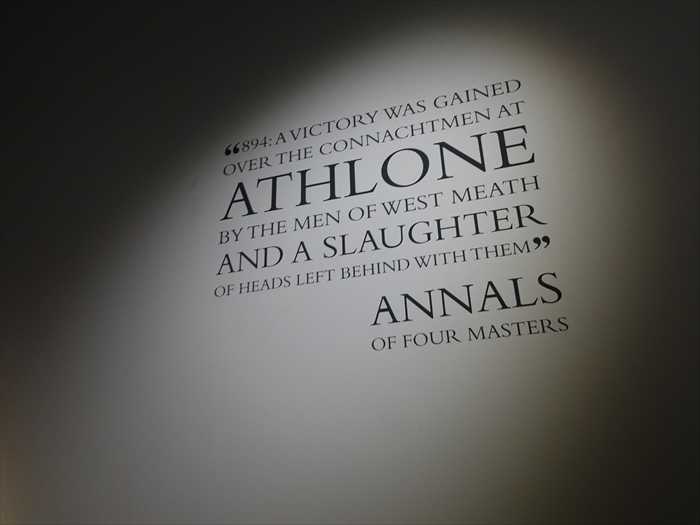
State under the provisions of the National Monuments Acts.
The Pubtic are requested to aid the Commissioners in preserving it.
Injury or defacement is severely punishabLe by Law.
【この国定記念物は、「国定記念物法」の規定に基づき、国家のために公共事業委員会の
管理下にあります。
一般の皆様には、この記念物の保護にご協力いただくようお願いいたします。
損傷や落書きなどの行為は、法律により厳しく罰せられます。】と。

「 ATHLONE CASTLE・アスローン城 」城内への 入口門 。

「 ATHLONE CASTLE・アスローン城 」は、アダムソン城とも呼ばれ、アイルランドの
ウェストミース州アスローンにある 12世紀に建てられた城 。
アスローンの記録に残る最古の「城」は、1129年にコノートの王タイアデルバッハ・ウア・
コンホベアによって建てられた木造建築物で、おそらく現在の城の場所に建てられたと
考えられている。現在も残る石造りの城は1210年に遡り、ジョン王のために、アイルランドの
法務長官であったノーリッジのジョン・ド・グレイ司教によって建てられた。
この城は、アスローンの川の渡河地点を守り、ノルマン人のコノートへの進軍を容易にする
ための橋頭堡となることを目的として建設された。
アスローン城ビジターセンター 。
アスローンの城の中に入ると写真の要塞塔があった。
要塞塔の中にはアスローン・キャスル・ビジターセンター があり、大規模な改修を経て
2012年にリニューアルオープンしたと。要塞塔の前に設置された2つの迫撃砲は、
ウィリアマイト戦争にまでさかのぼると考えられている。

城内には大砲の如き夜間照明装置が設置されていた。

アスローン城は博物館と体験型展示施設として大きく整備された と。
🔹 展示内容:
・アスローンの歴史・文化
・包囲戦の360度映像体験
・中世の暮らし、兵器、服装などのインタラクティブ展示
・サージェント・カスチュームなど英雄人物の紹介
・アイルランドの伝統音楽や詩人、ジョン・マコーマック(テノール歌手)の
・展示(2014年追加)
チケット売り場にあった 騎士像 。

城内の写真撮影はNO FLASHっであれば可と。

「 EARLY SETTLEMENT AT ATHLONE
Athlone is located on the intersectlon of along gravel ridge with the Shannon to provide
a convenient river crossing. Its name is anglicisation of the lrish Ath Luain,meaning
either the ford of Luan or the ford of the haunch. The recovery from the riverbed of
almost a score of Neolithic stone axeheads and more than fifty Bronze Age weapons
and ornarnents indicates the ford's importance in prehistoric times. Survivmg graveslabs
suggest that Athlone was an Early Christian settlernent site, but much inferior in
importance to Clonmacnoise, which that time was also the principal crossing point on
the mid-Shannon.
ln the twelfth century the balance swung in favour of Athlone with the rise to power of
the first bridges and castle, and used the crossing to make frequent belligerent incursions
into Meath. They also supported the church-reform movement by founding 3 Cluniac
priory on the west bank of the river.
【アスローンにおける初期の定住
アスローンは、砂利の多い長い尾根とシャノン川が交差する地点に位置し、川を渡るのに便利な
場所にあります。その地名「Athlone」は、アイルランド語の「Ath Luain(ア・ルアン)」の
英語化で、「ルアンの渡し場」または「腰(尻)の渡し場」という意味です
川底から発見された約20点の新石器時代の石斧や、50点を超える青銅器時代の武器・装飾品の
存在は、この渡し場が先史時代においても非常に重要だったことを示しています。
現存する墓石からは、アスローンが初期キリスト教時代に定住地であったことがうかがえますが、
当時の重要性は、同じくシャノン中流の主要な渡河地点であり宗教的中心でもあった
クロンマクノイズ(Clonmacnoise)には及びませんでした。
12世紀になると、アスローンの地位は大きく上昇します。最初の橋と城の建設によりこの場所の
戦略的価値が高まり、アスローンはしばしばミース地方(Meath)への軍事的侵攻の拠点として
使われるようになります。また、シャノン川西岸には、教会改革運動の一環としてクリュニ
(Cluniac)修道会による修道院が建設されました。】

「❝894。A VICTORY WAS GAINED OVER THE CONNACHTMEN AT
ATHL〇NE
BY THE MEN OF WEST MEATH
AND A SLAUGHTER
OF HEADS LEFT BEHIND WITH THEM❞
ANNALS
OF FOUR MASTERS」
【アイルランドの歴史書『 フォア・マスターズ年代記(Annals of the Four Masters) 』の一節】
894年。アスローンにおいて、ウェスト・ミースの人々がコノート人に勝利し、彼らに多くの
首を残していった(=大虐殺を行った)。
フォア・マスターズ年代記】

入り口ですぐに、 古代のキリスト教のレリーフと後期(17世紀)の紋章のプレート
が迎えてくれた。
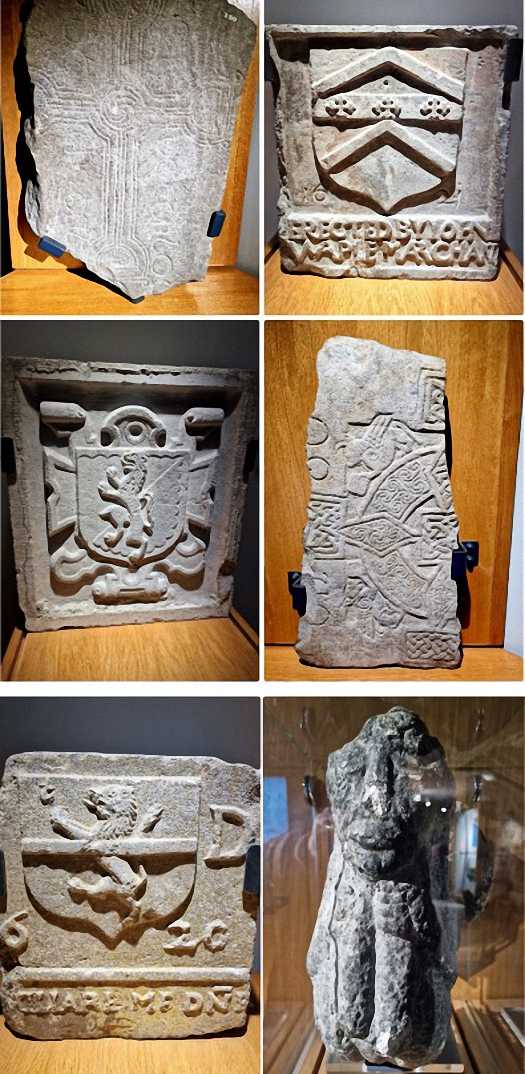
Evangelist Slab (Early Christian)・ 伝道者石板(初期キリスト教)

Evangelist Slab (Early Christian)
This sandstone slab of which the bottom half is missing, bears an elaborate ringed cross
that is decorated with spirals and interlace. A unique feature is the depiction of the
evangelists St. Mark and St. Luke on either side of the ring.

Evangelist Slab (Early Christian)・ 伝道者石板(初期キリスト教)

Evangelist Slab (Early Christian)
This sandstone slab of which the bottom half is missing, bears an elaborate ringed cross
that is decorated with spirals and interlace. A unique feature is the depiction of the
evangelists St. Mark and St. Luke on either side of the ring.
This slab is by far the most elaborate surviving commemorative stone of the Irish Early
Christian period and clearly commemorated a person of considerable importance.
This slab is inscribed OR DO. A further fragment, now in the collection of NMI,
depicts St. Matthew and is inscribed MUIR which are clearly the opening letters of the
deceased’s name, together with the letter M. Stylistically , the slab was the product of
a school of accomplished stone carving, centred on the midlands in the late 9th and 10th centuries.
【 伝道者石板(初期キリスト教)
下半分が欠損しているこの砂岩の板には、螺旋模様と絡み合った模様で装飾された精巧な
環状十字架が刻まれています。この十字架のユニークな特徴は、環状十字架の両側に福音記者の
聖マルコと聖ルカが描かれていることです。
この石板は、アイルランド初期キリスト教時代に現存する記念碑の中で、群を抜いて最も精巧な
ものであり、明らかに重要な人物を記念したものとされています。この石板には「OR DO」
刻まれています。また、現在NMIのコレクションにあるもう一つの断片には、聖マタイが描かれ、「MUIR」と刻まれています。これは明らかに故人の名の頭文字と「M」を合わせたものです。
この石板の様式は、9世紀後半から10世紀にかけてミッドランド地方を中心に活躍した、熟練した
石彫刻の一派の作品です。】

この石板は?
中央に円形の節点(結び目)があり、そこから四方に線状装飾が伸びる形式は、典型的な
ケルト十字(Celtic Cross)のモチーフ。
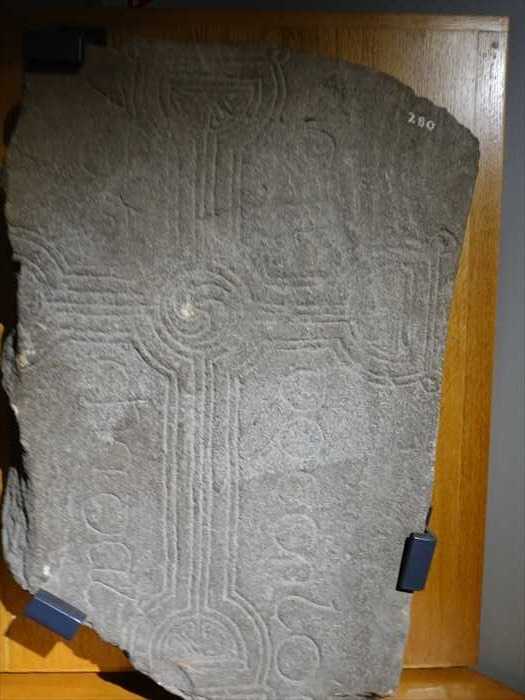
ピント不足で解読できなかったが。
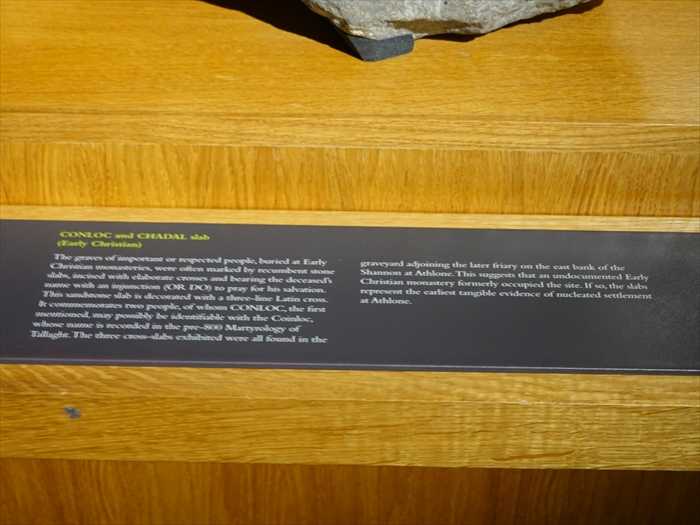
次の石板。

同様に。
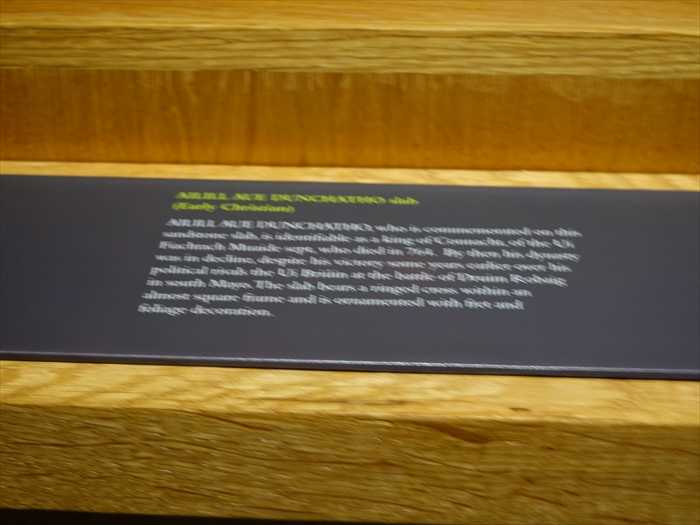
中央に BRONZE SHIELD REPLICA
A fortunate case of mistaken identity!A real treasure masqucrading as rubbish
【青銅の盾(複製品)幸運な誤認の一例!
本物の宝物が、まるでゴミのように見なされていたのです。】

1.Stone axeheads・石斧頭
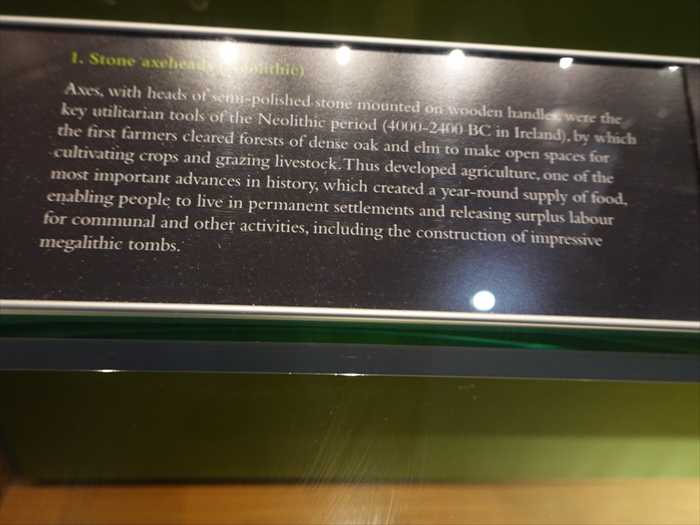
3.Stone adze(Neolithic)・石斧
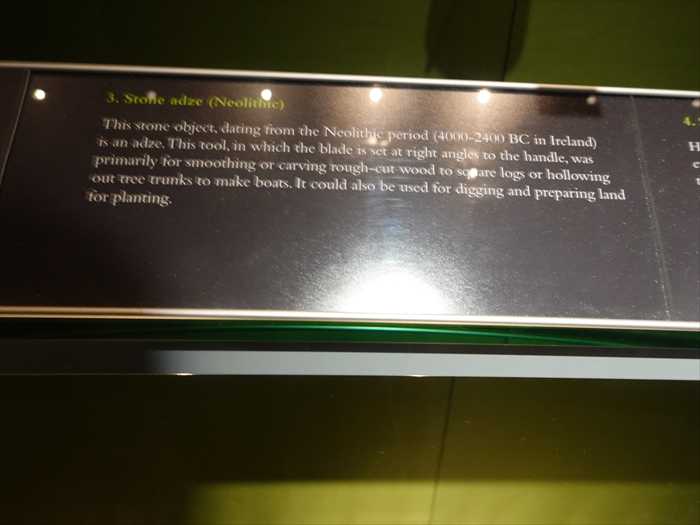
4.???
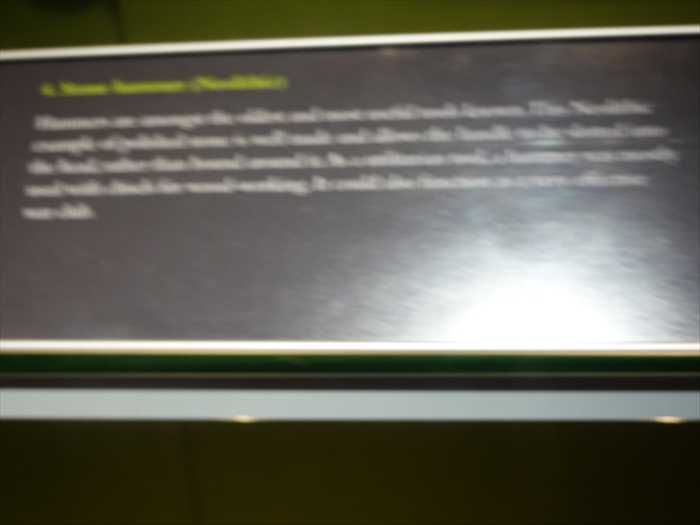
5.Bronze axehead
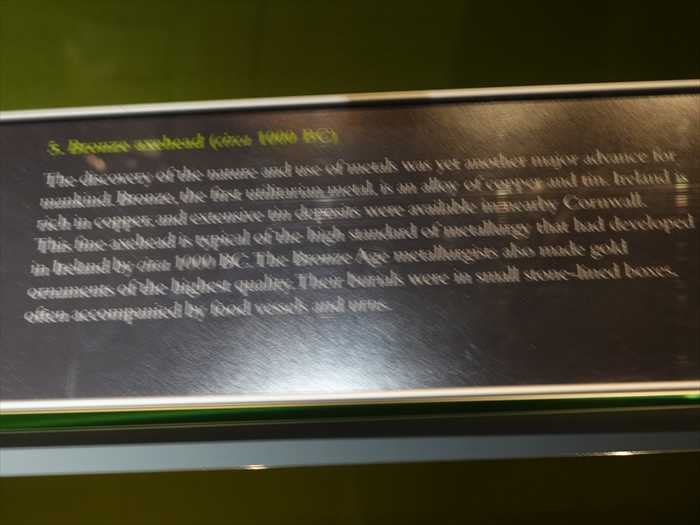
6.Bronze shield
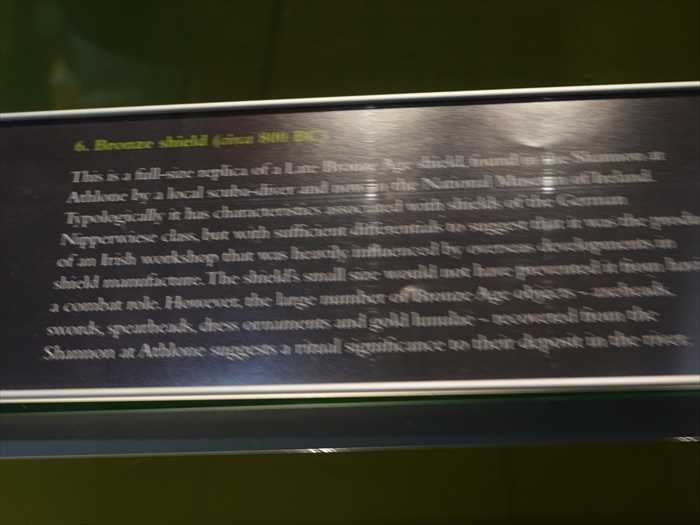
建設当初・1800年以降の 「Athron Castle・アスローン城」の姿か!?
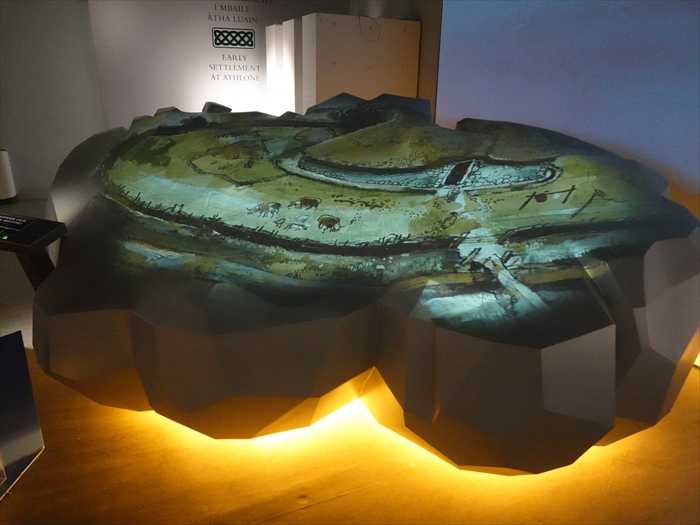
Quern - stones・ 石臼(いしうす)
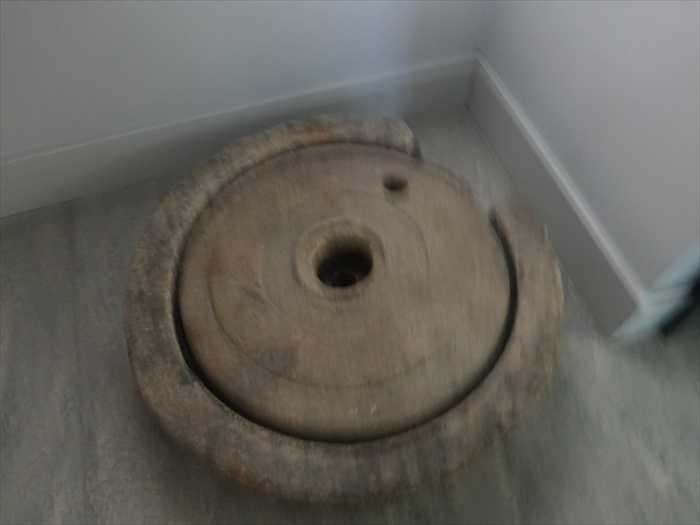
Pot-shaped rotary hand quern
Rotary quern stones were first introduced into Ireland circa 150 BC.
The device consists of two circular stones with matching surfaces, and is ‘pot-shaped’
where the lower quern has a raised edge or rim. Grain was fed into the hole in the
centre of the top stone, which was rotated by a manually operated handle inserted
near its edge. This process crushed the grain between the stones allowing the finished
flour to trickle out through the slot in the rim of the lower quern.
【 壺型の回転式手挽き臼(クォーン)
回転式の石臼は、紀元前150年ごろにアイルランドに初めて導入されました。
この装置は、表面が合うように作られた2枚の円形の石で構成されており、下の石臼に縁
(ふち)があることで“壺型”と呼ばれています。上の石の中央にある穴から穀物を投入し、
縁の近くに挿した取っ手を使って手で回転させます。
穀物は2枚の石の間ですり潰され、加工された粉は、下の石の縁に設けられた溝からこぼれ落ちる
仕組みになっています。】

在りし日の 「Athron Castle・アスローン城」の絵画。
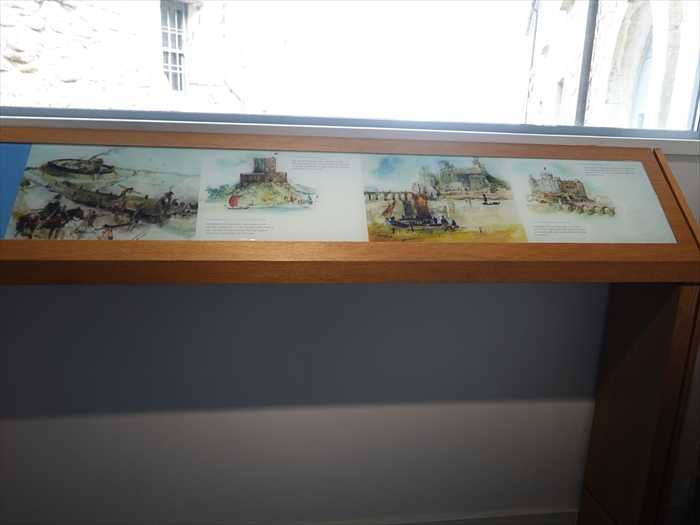
近づいて。
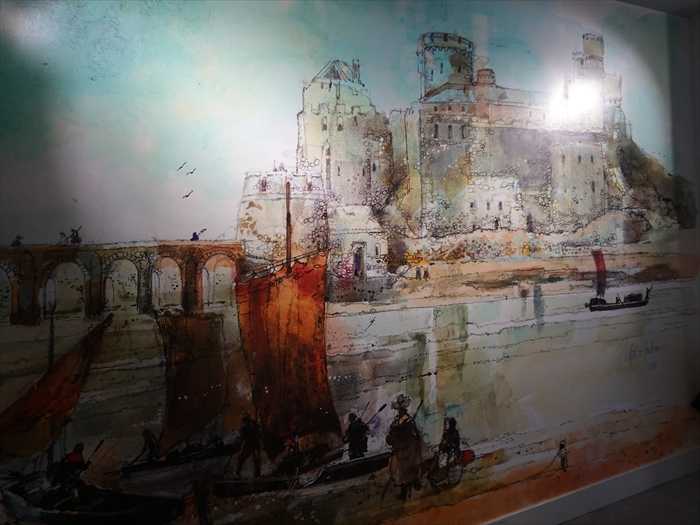
「 CHANGES TO THE CASTLE
Athlone is strategically important as the principal river crossing on the mid—Shannon.
This was recognised by King Toirrdelbach ua Conchobair of Connacht,who built the
first castle at Athlone to guard his new bridge.
An Anglo-Norman motte or fortifieied mound on the west bank that followed had the
same function.It formed the core of the present stone castle, originally started by the
lrish governor,Justicia rJohn de Gray.
On—going military and administrative use over the centuries brought many improvetnents
and additions.
The ca.stle's present appearance result from its remodelling as an artilldry platform and
small barracks soon after 1800.」
【 城の変遷
アスローンは、シャノン川中流における主要な渡河地点として戦略的に非常に重要な場所です。
このことを認識していたコノート王、トールデルバッハ・ウア・コンホバルは、自らが架けた
新しい橋を守るため、アスローンに最初の城を築きました。
その後、シャノン川西岸に築かれたアングロ・ノルマン様式のモット(人工的な土塁)または
要塞化された塚も、同様に橋を守る役割を果たしました。これが現在の石造りの城の中心部分を
成しており、もともとはアイルランドの総督であったジョン・デ・グレイが建設を開始した
ものです。
何世紀にもわたる軍事・行政上の利用により、城には多くの改良や増築が施されました。
現在の城の外観は、1800年以降まもなく、砲台と小規模な兵舎として再設計された際の姿に
由来しています。】
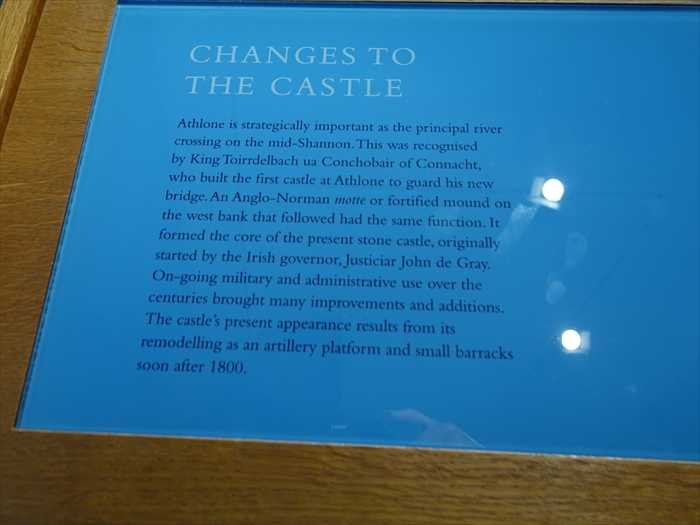
日本の 鎖帷(くさりかたびら) の原型か?
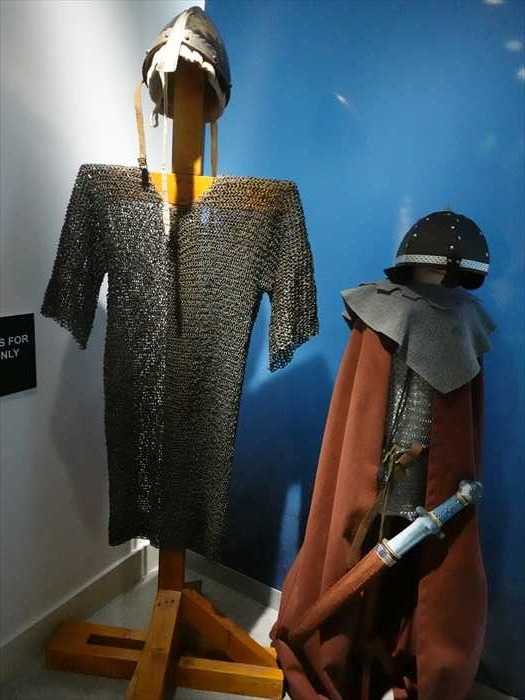
17TH CENTURY ARMORIAL PLAQUE
How to advertise your business the 17th century way
【 17世紀の紋章プレート — 17世紀流「ビジネス広告」の方法 —】
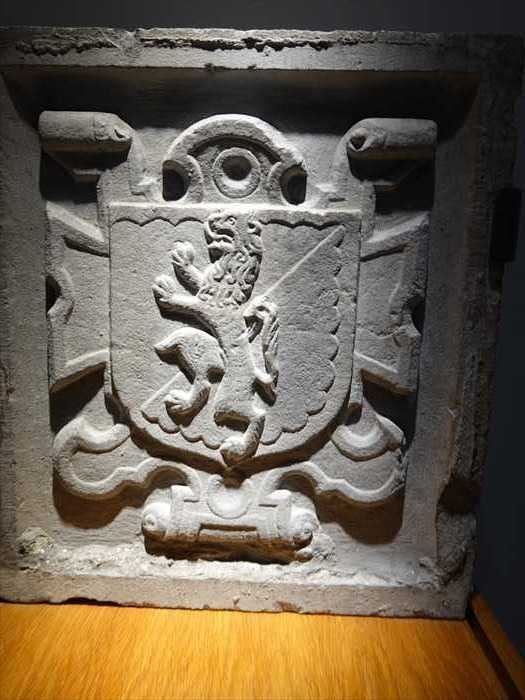

この紋章は?
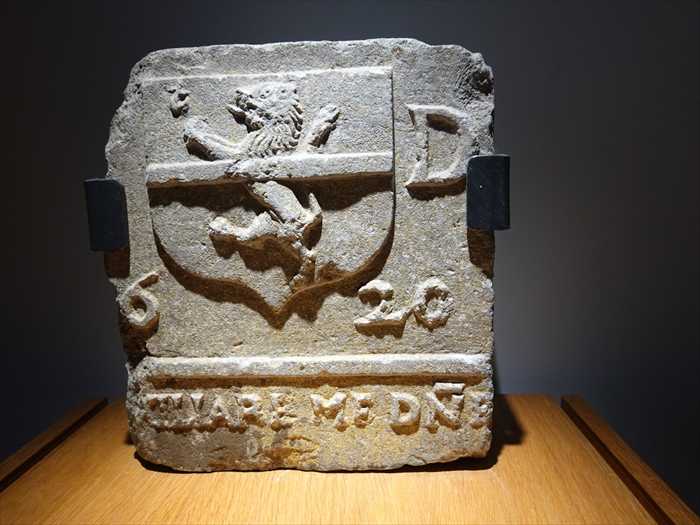
様々な石板や彫刻を展示。

「 medieval carving(中世の彫刻) 」
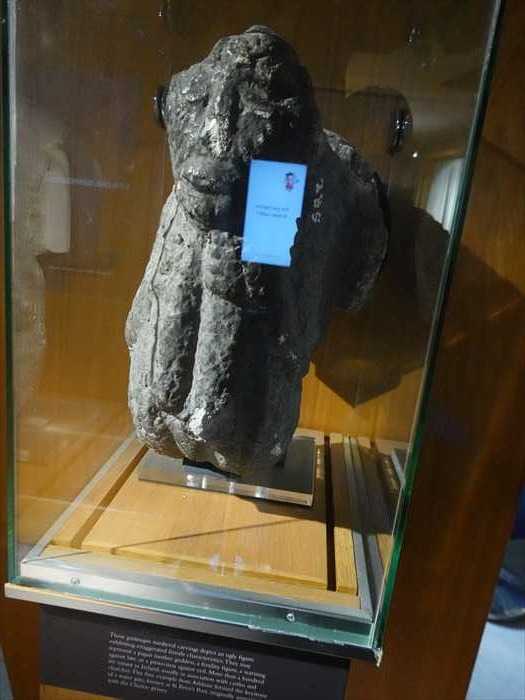
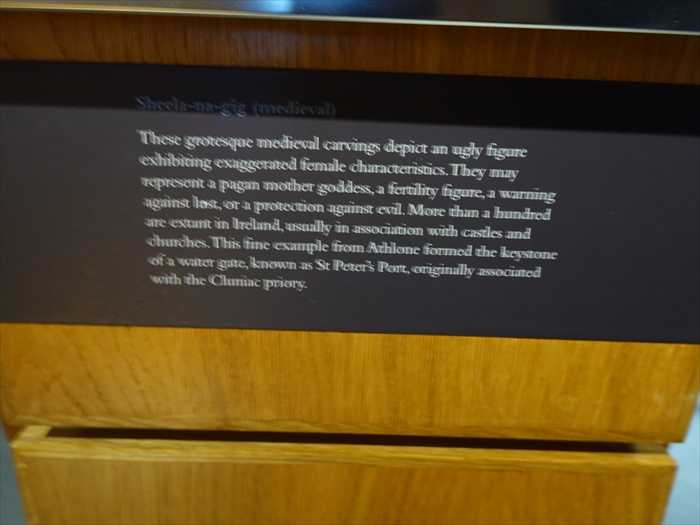
豪華な椅子。
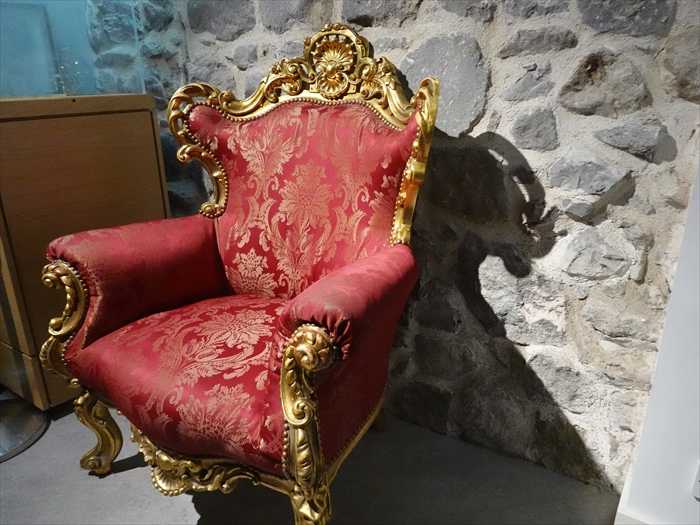
LONGBOW・長弓&CROSSBOW・ ・ 弩(石弓)
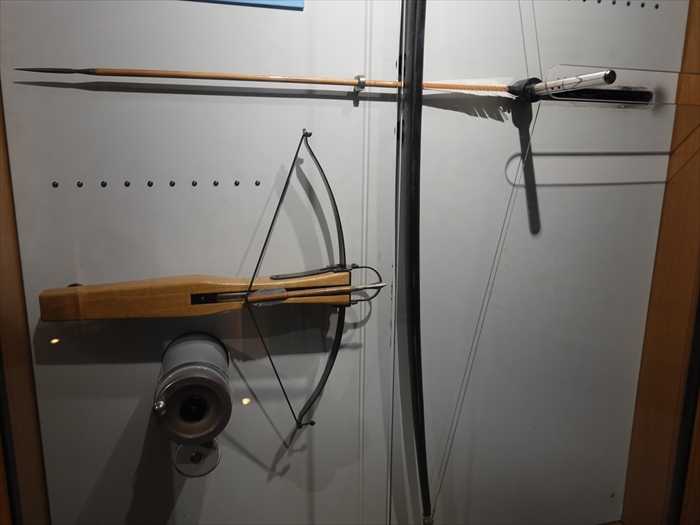
「 LONGBOW
The longbows were one of the most devastating infantry weapons of the medieval warfare,
at their most effective when discharged in a volley.Traditionary of yew and two metres long.
the bow was cheap to make,but required a drawing power of a 100 pounds or more.
Archers were trained from boyhood and expected to maintain their skills in peacetime.
A good bowman could fire off five arrows per minute.with a range of 350 metres or more.
The arrows,tipped with metal points that were sometimes barbed,could penetrate all
but the best-quality steel plate armour.The longbow was particularly favoured by the
English and was a major contributory to their success in pitched battles with the french
and Scots.In Ireland,longbow loops are often visible in the defences of castles.Can you
find one in the exterior wall of Athlone Castle? 」
【 ロングボウ(長弓)
Christian period and clearly commemorated a person of considerable importance.
This slab is inscribed OR DO. A further fragment, now in the collection of NMI,
depicts St. Matthew and is inscribed MUIR which are clearly the opening letters of the
deceased’s name, together with the letter M. Stylistically , the slab was the product of
a school of accomplished stone carving, centred on the midlands in the late 9th and 10th centuries.
【 伝道者石板(初期キリスト教)
下半分が欠損しているこの砂岩の板には、螺旋模様と絡み合った模様で装飾された精巧な
環状十字架が刻まれています。この十字架のユニークな特徴は、環状十字架の両側に福音記者の
聖マルコと聖ルカが描かれていることです。
この石板は、アイルランド初期キリスト教時代に現存する記念碑の中で、群を抜いて最も精巧な
ものであり、明らかに重要な人物を記念したものとされています。この石板には「OR DO」
刻まれています。また、現在NMIのコレクションにあるもう一つの断片には、聖マタイが描かれ、「MUIR」と刻まれています。これは明らかに故人の名の頭文字と「M」を合わせたものです。
この石板の様式は、9世紀後半から10世紀にかけてミッドランド地方を中心に活躍した、熟練した
石彫刻の一派の作品です。】

この石板は?
中央に円形の節点(結び目)があり、そこから四方に線状装飾が伸びる形式は、典型的な
ケルト十字(Celtic Cross)のモチーフ。

ピント不足で解読できなかったが。

次の石板。

同様に。

中央に BRONZE SHIELD REPLICA
A fortunate case of mistaken identity!A real treasure masqucrading as rubbish
【青銅の盾(複製品)幸運な誤認の一例!
本物の宝物が、まるでゴミのように見なされていたのです。】

1.Stone axeheads・石斧頭

3.Stone adze(Neolithic)・石斧

4.???

5.Bronze axehead

6.Bronze shield

建設当初・1800年以降の 「Athron Castle・アスローン城」の姿か!?

Quern - stones・ 石臼(いしうす)

Pot-shaped rotary hand quern
Rotary quern stones were first introduced into Ireland circa 150 BC.
The device consists of two circular stones with matching surfaces, and is ‘pot-shaped’
where the lower quern has a raised edge or rim. Grain was fed into the hole in the
centre of the top stone, which was rotated by a manually operated handle inserted
near its edge. This process crushed the grain between the stones allowing the finished
flour to trickle out through the slot in the rim of the lower quern.
【 壺型の回転式手挽き臼(クォーン)
回転式の石臼は、紀元前150年ごろにアイルランドに初めて導入されました。
この装置は、表面が合うように作られた2枚の円形の石で構成されており、下の石臼に縁
(ふち)があることで“壺型”と呼ばれています。上の石の中央にある穴から穀物を投入し、
縁の近くに挿した取っ手を使って手で回転させます。
穀物は2枚の石の間ですり潰され、加工された粉は、下の石の縁に設けられた溝からこぼれ落ちる
仕組みになっています。】

在りし日の 「Athron Castle・アスローン城」の絵画。

近づいて。

「 CHANGES TO THE CASTLE
Athlone is strategically important as the principal river crossing on the mid—Shannon.
This was recognised by King Toirrdelbach ua Conchobair of Connacht,who built the
first castle at Athlone to guard his new bridge.
An Anglo-Norman motte or fortifieied mound on the west bank that followed had the
same function.It formed the core of the present stone castle, originally started by the
lrish governor,Justicia rJohn de Gray.
On—going military and administrative use over the centuries brought many improvetnents
and additions.
The ca.stle's present appearance result from its remodelling as an artilldry platform and
small barracks soon after 1800.」
【 城の変遷
アスローンは、シャノン川中流における主要な渡河地点として戦略的に非常に重要な場所です。
このことを認識していたコノート王、トールデルバッハ・ウア・コンホバルは、自らが架けた
新しい橋を守るため、アスローンに最初の城を築きました。
その後、シャノン川西岸に築かれたアングロ・ノルマン様式のモット(人工的な土塁)または
要塞化された塚も、同様に橋を守る役割を果たしました。これが現在の石造りの城の中心部分を
成しており、もともとはアイルランドの総督であったジョン・デ・グレイが建設を開始した
ものです。
何世紀にもわたる軍事・行政上の利用により、城には多くの改良や増築が施されました。
現在の城の外観は、1800年以降まもなく、砲台と小規模な兵舎として再設計された際の姿に
由来しています。】

日本の 鎖帷(くさりかたびら) の原型か?

17TH CENTURY ARMORIAL PLAQUE
How to advertise your business the 17th century way
【 17世紀の紋章プレート — 17世紀流「ビジネス広告」の方法 —】

この写真は、アスローン城(Athlone Castle)に展示されていた石製の盾型の紋章
(ハーバルディック・シールド)と記念碑です。
(ハーバルディック・シールド)と記念碑です。
中央には、ヘラルディック(紋章学)に基づく盾のデザインが彫刻されています。
上部の横帯(バー)には三つの花模様があり、その下には逆V字型の模様が刻まれています。
上部の横帯(バー)には三つの花模様があり、その下には逆V字型の模様が刻まれています。
盾の左右には数字「16」と「21」が彫られており、1621年にこの石が設置されたことを
示している。
示している。
下部には大文字で次のような刻字がある。
「ERECTED BY W. MAPE MARCHAN」
これはおそらく次のように解釈できます:
ERECTED BY(建立者)=「〜によって建てられた」
W. MAPE は人物名(例:William Mape)
MARCHAN は姓または職名(「Merchant=商人」の古綴りの可能性もあります)
つまり、この石は1621年にウィリアム・マープ(W. Mape)という人物によって建立された
ものである可能性が高い。
ものである可能性が高い。

この紋章は?
左右に分かれた帯の上に、ライオン(またはそれに似た動物)のレリーフが彫られています。
このような構図は、英国やアイルランドの貴族・軍人階級の紋章でよく見られるもので、
「勇敢さ」や「戦いの名誉」などを象徴。
左下に「6」、右下に「20」とあり、これを合わせると1620年を意味。
この石は、1620年、マープ氏によって建立されたものであり、主よ、私をお守りください と。
「勇敢さ」や「戦いの名誉」などを象徴。
左下に「6」、右下に「20」とあり、これを合わせると1620年を意味。
この石は、1620年、マープ氏によって建立されたものであり、主よ、私をお守りください と。

様々な石板や彫刻を展示。

「 medieval carving(中世の彫刻) 」


豪華な椅子。

LONGBOW・長弓&CROSSBOW・ ・ 弩(石弓)

「 LONGBOW
The longbows were one of the most devastating infantry weapons of the medieval warfare,
at their most effective when discharged in a volley.Traditionary of yew and two metres long.
the bow was cheap to make,but required a drawing power of a 100 pounds or more.
Archers were trained from boyhood and expected to maintain their skills in peacetime.
A good bowman could fire off five arrows per minute.with a range of 350 metres or more.
The arrows,tipped with metal points that were sometimes barbed,could penetrate all
but the best-quality steel plate armour.The longbow was particularly favoured by the
English and was a major contributory to their success in pitched battles with the french
and Scots.In Ireland,longbow loops are often visible in the defences of castles.Can you
find one in the exterior wall of Athlone Castle? 」
【 ロングボウ(長弓)
ロングボウは中世の戦争において、歩兵が使用する最も破壊的な武器の一つでした。
特に、一斉射撃(ボレー)で放たれたときに最大の効果を発揮しました。
特に、一斉射撃(ボレー)で放たれたときに最大の効果を発揮しました。
伝統的にイチイの木で作られ、全長は約2メートル。製作コストは安価でしたが、100ポンド
(約45キログラム)以上の引きの力が必要でした。
(約45キログラム)以上の引きの力が必要でした。
弓兵たちは少年時代から訓練を受け、平時でもその技能を維持することが求められました。
熟練した射手であれば、1分間に5本の矢を射ることができ、射程は350メートル以上に及びました。
熟練した射手であれば、1分間に5本の矢を射ることができ、射程は350メートル以上に及びました。
金属製の先端(時にはかえし付き)を備えた矢は、最高級の鋼鉄製プレートアーマー以外は
貫通することができました。
貫通することができました。
ロングボウは特にイングランドで好まれ、フランスやスコットランドとの決戦における勝利に
大きく貢献しました。
大きく貢献しました。
アイルランドでは、ロングボウ用の狭間(射撃口)がしばしば城の防御構造に見られます。
アスローン城の外壁に、ひとつ見つけられますか?】
「 CROSSBOW
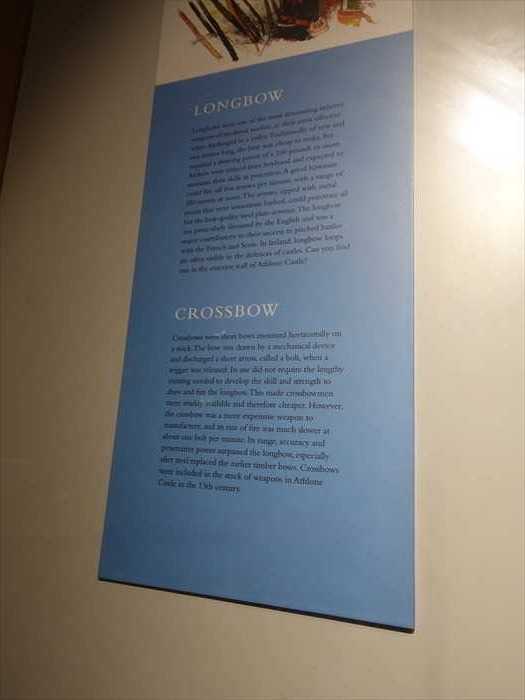
・・・ もどる ・・・
・・・ つづく ・・・
「 CROSSBOW
Crossbows were short bows mounted horizontally on a stock.The bow was drawn by
a mechanical device dischanged a short arrow,called a bolt,when a trigger was released.
Its use did not require the lengthy train ning needed to develop the skill and strength to
a mechanical device dischanged a short arrow,called a bolt,when a trigger was released.
Its use did not require the lengthy train ning needed to develop the skill and strength to
draw and fire the longbow. This made crossbowmen more expensive weapon to
manufacture,and its rate fire was much slower at about one bolt per minute. lts range,
accuracy and penetrative power surpassed the longbow, especially after steel replaced the
earlier timber bows. Crossbows were included in the stock of weapons in Athlone Castle
in 13th century.」
【 クロスボウ(弩)
manufacture,and its rate fire was much slower at about one bolt per minute. lts range,
accuracy and penetrative power surpassed the longbow, especially after steel replaced the
earlier timber bows. Crossbows were included in the stock of weapons in Athlone Castle
in 13th century.」
【 クロスボウ(弩)
クロスボウは、銃床のような台座に水平に取り付けられた短い弓です。弓は機械装置で引かれ、
引き金が引かれると「ボルト」と呼ばれる短い矢が発射されました。
引き金が引かれると「ボルト」と呼ばれる短い矢が発射されました。
その使用には、ロングボウを引いて撃つために必要な長期の訓練や筋力は不要でした。
このためクロスボウの兵士の方が訓練は簡単でしたが、武器自体の製造コストは高く、発射速度は
非常に遅く、1分間に1本程度のボルトしか撃てませんでした。
非常に遅く、1分間に1本程度のボルトしか撃てませんでした。
しかしその射程、命中精度、貫通力はロングボウを上回っており、特に木製の弓から鋼鉄製に
変わってからはその性能が格段に向上しました。
変わってからはその性能が格段に向上しました。

・・・ もどる ・・・
・・・ つづく ・・・
お気に入りの記事を「いいね!」で応援しよう
【毎日開催】
15記事にいいね!で1ポイント
10秒滞在
いいね!
--
/
--
© Rakuten Group, Inc.










